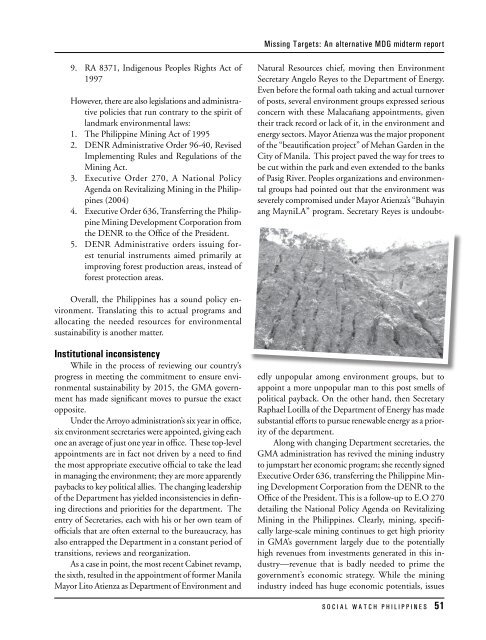one big file - Social Watch
one big file - Social Watch
one big file - Social Watch
Create successful ePaper yourself
Turn your PDF publications into a flip-book with our unique Google optimized e-Paper software.
Missing Targets: An alternative MDG midterm report<br />
9. RA 8371, Indigenous Peoples Rights Act of<br />
1997<br />
However, there are also legislations and administrative<br />
policies that run contrary to the spirit of<br />
landmark environmental laws:<br />
1. The Philippine Mining Act of 1995<br />
2. DENR Administrative Order 96-40, Revised<br />
Implementing Rules and Regulations of the<br />
Mining Act.<br />
3. Executive Order 270, A National Policy<br />
Agenda on Revitalizing Mining in the Philippines<br />
(2004)<br />
4. Executive Order 636, Transferring the Philippine<br />
Mining Development Corporation from<br />
the DENR to the Office of the President.<br />
5. DENR Administrative orders issuing forest<br />
tenurial instruments aimed primarily at<br />
improving forest production areas, instead of<br />
forest protection areas.<br />
Overall, the Philippines has a sound policy environment.<br />
Translating this to actual programs and<br />
allocating the needed resources for environmental<br />
sustainability is another matter.<br />
Institutional inconsistency<br />
While in the process of reviewing our country’s<br />
progress in meeting the commitment to ensure environmental<br />
sustainability by 2015, the GMA government<br />
has made significant moves to pursue the exact<br />
opposite.<br />
Under the Arroyo administration’s six year in office,<br />
six environment secretaries were appointed, giving each<br />
<strong>one</strong> an average of just <strong>one</strong> year in office. These top-level<br />
appointments are in fact not driven by a need to find<br />
the most appropriate executive official to take the lead<br />
in managing the environment; they are more apparently<br />
paybacks to key political allies. The changing leadership<br />
of the Department has yielded inconsistencies in defining<br />
directions and priorities for the department. The<br />
entry of Secretaries, each with his or her own team of<br />
officials that are often external to the bureaucracy, has<br />
also entrapped the Department in a constant period of<br />
transitions, reviews and reorganization.<br />
As a case in point, the most recent Cabinet revamp,<br />
the sixth, resulted in the appointment of former Manila<br />
Mayor Lito Atienza as Department of Environment and<br />
Natural Resources chief, moving then Environment<br />
Secretary Angelo Reyes to the Department of Energy.<br />
Even before the formal oath taking and actual turnover<br />
of posts, several environment groups expressed serious<br />
concern with these Malacañang appointments, given<br />
their track record or lack of it, in the environment and<br />
energy sectors. Mayor Atienza was the major prop<strong>one</strong>nt<br />
of the “beautification project” of Mehan Garden in the<br />
City of Manila. This project paved the way for trees to<br />
be cut within the park and even extended to the banks<br />
of Pasig River. Peoples organizations and environmental<br />
groups had pointed out that the environment was<br />
severely compromised under Mayor Atienza’s “Buhayin<br />
ang MayniLA” program. Secretary Reyes is undoubtedly<br />
unpopular among environment groups, but to<br />
appoint a more unpopular man to this post smells of<br />
political payback. On the other hand, then Secretary<br />
Raphael Lotilla of the Department of Energy has made<br />
substantial efforts to pursue renewable energy as a priority<br />
of the department.<br />
Along with changing Department secretaries, the<br />
GMA administration has revived the mining industry<br />
to jumpstart her economic program; she recently signed<br />
Executive Order 636, transferring the Philippine Mining<br />
Development Corporation from the DENR to the<br />
Office of the President. This is a follow-up to E.O 270<br />
detailing the National Policy Agenda on Revitalizing<br />
Mining in the Philippines. Clearly, mining, specifically<br />
large-scale mining continues to get high priority<br />
in GMA’s government largely due to the potentially<br />
high revenues from investments generated in this industry—revenue<br />
that is badly needed to prime the<br />
government’s economic strategy. While the mining<br />
industry indeed has huge economic potentials, issues<br />
S O C I A L W A T C H P H I L I P P I N E S 51

















